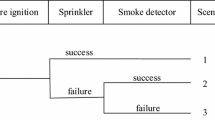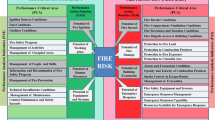Abstract
An integrated probabilistic risk assessment methodology is developed for the purpose of quantifying the life safety level of people present in buildings in the context of fire safety design. Multiple risk based concepts and tools have been developed in previous research to objectify performance based design methods for simple building types and layouts. However, these available models lack an integrated approach for challenging building designs and moreover they are not adequately coupled, most often resulting in a significant computational effort. Hence, there is a need for a practical and efficient framework for dealing with complicated building layouts and different occupancy types. Therefore, a computationally efficient quantitative risk assessment method is developed that provides a framework by combining deterministic sub-models and probabilistic techniques to quantify the fire safety level by means of failure probabilities, individual and societal risk. The deterministic framework is supported by analytical and numerical models. The probabilistic framework is supported by response surface modelling, sampling techniques and limit state design. Following the theoretical description of the model, a case study of a five storey commercial shopping mall of 25,000 m2 is elaborated and discussed as proof of concept. Multiple fire, building and occupant variables are implemented in the model. Three different fire safety designs are compared, resulting in quantified risks between 10−6 and 10−8. The case study proves the validity of the newly developed integrated methodology for this type of buildings and its benefits in fire safety engineering.

















Similar content being viewed by others
References
Maluk C, Woodrow M, Torero JL (2017) The potential of integrating fire safety in modern building design. Fire Saf J 88:104–112. https://doi.org/10.1016/j.firesaf.2016.12.006
Meacham BJ (2004) Decision-making for fire risk problems: a review of challenges and tools. J Fire Prot Eng 14:149–168. https://doi.org/10.1177/1042391504040262
Fischer K, De Sanctis G, Kohler J et al (2015) Combining engineering and data-driven approaches: calibration of a generic fire risk model with data. Fire Saf J 74:32–42. https://doi.org/10.1016/j.firesaf.2015.04.008
Meacham B, Bowen R, Traw J, Moore A (2005) Performance-based building regulation: current situation and future needs. Build Res Inf 33:91–106
Meacham BJ (1998) The evolution of performance based codes and fire safety design methods, NIST-GCR-98-761. United States
Spinardi G (2016) Fire safety regulation: Prescription, performance, and professionalism. Fire Saf J 80:83–88. https://doi.org/10.1016/j.firesaf.2015.11.012
Wolski A, Dembsey N, Meacham BJ (2000) Accommodating perceptions of risk in performance-based building fire safety code development. Fire Saf J 34:297–309
Meacham BJ (2000) International experience in the development and use of performance-based fire safety design methods: evolution, current situation and thoughts for the future. In: The 6th international symposium on fire safety science, pp 59–76
Hadjisophocleous G, Fu Z (2004) Literature review of fire risk assessment methodologies. Int J Eng Perform Based Fire Codes 6:28–45
Alvarez A, Meacham BJ, Dembsey N, Thomas J (2013) Twenty years of performance-based fire protection design: challenges faced and a look ahead. J Fire Prot Eng 23:249–276. https://doi.org/10.1177/1042391513484911
Alvarez A (2012) An integrated framework for the next generation of risk-informed performance-based design approach used in fire safety engineering. WPI, Worcester
SFPE (2007) SFPE engineering guide to performance-based fire protection. SFPE,Worchester
Fleischmann CM (2011) Is prescription the future of performance-based design? In: The 10th international symposium on fire safety science, Christchurch, New Zealand, pp 77–94
Kong D, Lu S, Frantzich H, Lo SM (2013) A method for linking safety factor to the target probability of failure in fire safety engineering. J Civ Eng Manag 19:S212–S221. https://doi.org/10.3846/13923730.2013.802718
PD7974-7 (2003) Application of fire safety engineering principles to the design of buildings—Part 7: probabilistic risk assessment. London, UK
National Fire Protection Association (2016) NFPA 551: guide for the evaluation of fire risk assessments. National Fire Protection Association, Quincy, USA
Society of Fire Protection Engineers (2006) SFPE Engineering Guide: Fire Risk Assessment.
ISO 16732-1:2012 preview fire safety engineering—fire risk assessment—Part 1: general.
Yung D (2008) Principles of fire risk assessment in buildings. Wiley, London
Chu G, Sun J (2008) Decision analysis on fire safety design based on evaluating building fire risk to life. Saf Sci 46:1125–1136. https://doi.org/10.1016/j.ssci.2007.06.011
Hall JR, Sekizawa A (1991) Fire risk analysis: general conceptual framework for describing models. Fire Technol 27:33–53. https://doi.org/10.1007/bf01039526
Alvarez A, Meacham BJ, Dembsey NA, Thomas JR (2013) A framework for risk-informed performance-based fire protection design for the built environment. Fire Technol 50:161–181. https://doi.org/10.1007/s10694-013-0366-1
Kong D, Lu S, Kang Q et al (2014) Fuzzy risk assessment for life safety under building fires. Fire Technol 50:977–991. https://doi.org/10.1007/s10694-011-0223
Pires TT, Almeida AT De, Lemos DC et al (2005) A decision-aided fire risk analysis. Fire Technol 41:25–35
Hall JR, Sekizawa A (2010) Revisiting our 1991 paper on fire risk assessment. Fire Technol 46:789–801. https://doi.org/10.1007/s10694-010-0146-0
De Sanctis G (2015) Generic risk assessment for fire safety—performance evaluation and optimisation of design provisions. ETH Zürich, Switzerland. https://doi.org/10.3929/ethz-a-010562998
Van Weyenberge B, Deckers X, Caspeele R, Merci B (2015) Development of a risk assessment method for life safety in case of fire in rail tunnels. Fire Technol 52:1465–1479. https://doi.org/10.1007/s10694-015-0469-y
Albrecht C (2014) Quantifying life safety: part I: scenario-based quantification. Fire Saf J 64:87–94. https://doi.org/10.1016/j.firesaf.2014.01.003
Van Weyenberge B, Criel P, Deckers X et al (2017) Response surface modelling in quantitative risk analysis for life safety in case of fire. Fire Saf J. https://doi.org/10.1016/j.firesaf.2017.03.020
SFPE (2016) SFPE handbook of fire protection engineering, Fifth, USA. https://doi.org/10.1007/978-1-4939-2565-0
Barry T (2002) Risk-informed, performance-based industrial fire protection. TVP, USA
BSI (1994) Draft British Standard Code of practice for the application of fire safety engineering principles to fire safety in buildings. London, UK
Meacham B (2016) Ultimate health & safety (UHS) quantification: individual and societal risk quantification for use in National Construction Code (NCC). BCA, pp 45–100
Meacham BJ, Van Straalen IJ (2017) A socio-technical system framework for risk- informed performance-based building regulation. Build Res Inf 46:444–462. https://doi.org/10.1080/09613218.2017.1299525
Hadjisophocleous GV, Benichou N (1999) Performance criteria used in fire safety design. Autom Constr 8:489–501
Oliphant TE (2007) Python for scientific computing python overview. Comput Sci Eng 9:10–20. https://doi.org/10.1109/mcse.2007.58
MathWorks T (2017) MATLAB and statistics toolbox release 2017a Version 9.2
Borg A, Njå O, Torero JL (2015) A framework for selecting design fires in performance based fire safety engineering. Fire Technol 51:995–1017. https://doi.org/10.1007/s10694-014-0454-x
Kong D, Lu S, Ping P (2017) A risk-based method of deriving design fires fore evacuation safety in buildings. Fire Technol 53:771–791. https://doi.org/10.1007/s10694-016-0600-8
Van Weyenberge B (2013) Development of a risk assessment methodology for fire in rail tunnels. Ghent University, Gent
Albrecht C (2012) A risk-informed and performance-based life safety concept in case of fire. TU, Braunschweig
Salgueiro OP, Jönsson J, Vigne G (2016) Sensitivity analysis for modelling parameters used for advanced evacuation simulations—how important are the modelling parameters when conducting evacuation modelling. In: SFPE performance-based design conference
Sandberg M (2004) Statistical determination of ignition frequency. Lund University, Lund
Nilsson M, Johansson N, Van Hees P (2014) A new method for quantifying fire growth rates using statistical and empirical data—applied to determine the effect of arson. Fire Saf Sci 11:517–530. https://doi.org/10.3801/IAFSS.FSS.11-517
Deguchi Y, Notake H, Yamaguchi J, Tanaka T (2011) Statistical estimations of the distribution of fire growth factor—study on risk-based evacuation safety design method. Fire Saf Sci 10:1087–1100. https://doi.org/10.3801/IAFSS.FSS.10-1087
Holborn PG, Nolan PF, Golt J (2004) An analysis of fire sizes, fire growth rates and times between events using data from fire investigations. Fire Saf J 39:481–524. https://doi.org/10.1016/j.firesaf.2004.05.002
Ministry of Business Innovation and Employment (2013) C/VM2 verification method: framework for fire safety design For New Zealand Building Code Clauses C1-C6 Protection from Fire
Marsh (2012) Fire system effectiveness in major buildings. Marsh, Auckland
Zhao L (1997) Reliability of stair pressurisation and zoned smoke control systems. ABCB, Victoria, Australia
Tillander K, Keski-Rahkonen O (2003) The ignition frequency of structural fires in Finland 1996–99. Fire Saf Sci 7:1051–1062. https://doi.org/10.3801/iafss.fss.7-1051
Leira BJ (2013) Optimal stochastic control schemes within a structural reliability framework. SpringerBriefs in Statistics. https://doi.org/10.1007/978-3-319-01405-0
Suard S, Hostikka S, Baccou J (2013) Sensitivity analysis of fire models using a fractional factorial design. Fire Saf J 62:115–124. https://doi.org/10.1016/j.firesaf.2013.01.031
Morris M (1991) Factorial sampling plans for preliminary computational experiments. Technometrics 33:161–174. https://doi.org/10.2307/1269043
McGrattan K, McDermott R, Floyd J, et al. (2012) Computational fluid dynamics modelling of fire. Int J Comput Fluid Dyn 26:349–361. https://doi.org/10.1080/10618562.2012.659663
Albrecht C (2014) Quantifying life safety Part II: quantification of fire protection systems. Fire Saf J 64:81–86. https://doi.org/10.1016/j.firesaf.2014.01.002
Wiener N (1938) The homogeneous chaos. J Appl Math 60:897–936. http://dx.doi.org/10.2307/2371268
Hoerl AE, Kennard RW (1970) Ridge regression: application to nonorthogonal problems. Technometrics 12:69–82. https://doi.org/10.1080/00401706.1970.10488634
Helton JC, Davis FJ (2002) Latin hypercube sampling and the propagation of uncertainty in analyses of complex systems. Reliab Eng Syst Saf 81:23–69. https://doi.org/10.1016/s0951-8320(03)00058-9
Sobol IM (1967) On the distribution of points in a cube and the approximate evaluation of integrals. USSR Comput Math & Math Phys 7:784–802. https://doi.org/10.1016/0041-5553(67)90144-9
Thornton C, O’Konski R, Hardeman B et al (2011) Pathfinder: an agent-based egress simulator. Evacuation Dyn. https://doi.org/10.1007/978-1-4419-9725-8
Ulrich A, Wagoum K, Chraibi M et al (2015) JuPedSim: an open framework for simulating and analyzing the dynamics of pedestrians. In: Conference of Transportation Research Group of India
Purser DA, Maynard RL, Wakefield JC (2016) Toxicology, survival and health hazards of combustion products. RSC, Cambridge
ISO TC 98 (2015) Iso 2394 General principles on reliability for structures, reliability of structures.
Bottelberghs PH (2000) Risk analysis and safety policy developments in the Netherlands. J Hazard Mater 71:59–84. https://doi.org/10.1016/s0304-3894(99)00072-2
CEN (2015) NBN EN 12845: 2015 Fixed firefighting systems—automatic sprinkler systems—design, installation and maintenance, Brussels, Belgium
Acknowledgements
The authors would like to thank the Flanders Innovation and Entrepreneurship (VLAIO) for supporting project number 130857 for this research.
Author information
Authors and Affiliations
Corresponding author
Additional information
Publisher's Note
Springer Nature remains neutral with regard to jurisdictional claims in published maps and institutional affiliations.
Rights and permissions
About this article
Cite this article
Van Weyenberge, B., Deckers, X., Caspeele, R. et al. Development of an Integrated Risk Assessment Method to Quantify the Life Safety Risk in Buildings in Case of Fire. Fire Technol 55, 1211–1242 (2019). https://doi.org/10.1007/s10694-018-0763-6
Received:
Accepted:
Published:
Issue Date:
DOI: https://doi.org/10.1007/s10694-018-0763-6




